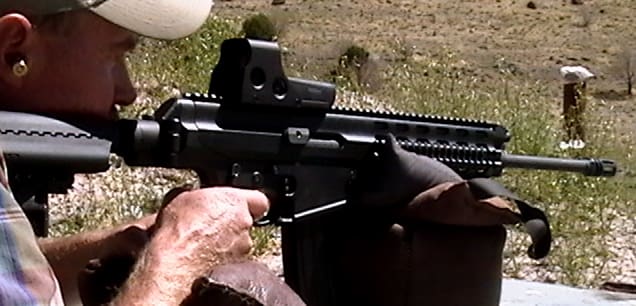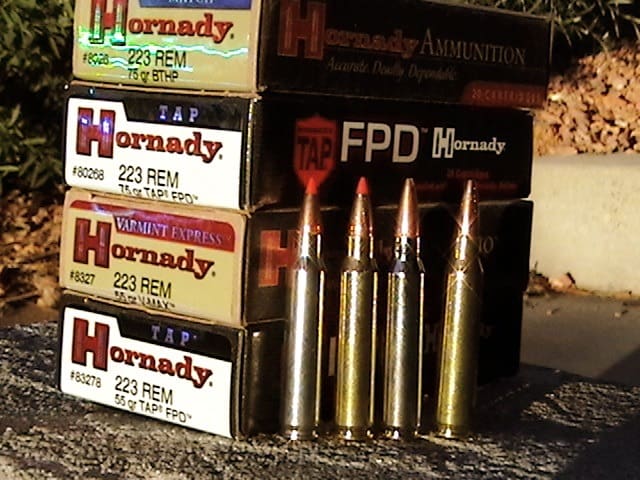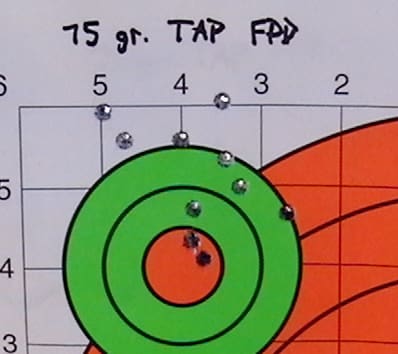Do you want a rifle that goes BANG every time you pull the trigger or a highly evolved weapon with excellent ergonomics, superior accuracy and endless customization? Yes! Unfortunately, American rifles tend to divide between AK (rough and ready) and AR (hot rod). The underlying assumption: they’re mutually exclusive platforms. Maybe not. Robinson Arms’ XCR-L rifle combines the reliability of the AK-47’s gas-operated, piston-driven system, three-lug rotating bolt, beefy extractor and fixed ejector with the superior ergonomics and accuracy of the AR platform—with a dash of FN-FAL for added finesse. Or does it?
The XCR-L has scars from its past. Alex J. Robinson developed the weapon system for the big Kahuna: the U.S. Special Operations Command (SOCOM) SOF Combat Assault Rifle contract. The XCR-L was disqualified on a technicality, relegating the weapon to small military contracts, and law enforcement and civilian sales.
The XCR-L’s headline innovation: maximum modularity. Thanks to the way the bolt locks into the barrel extension, a shooter can swap out the pipe without worrying about head-spacing. Caliber conversions require a hex wrench, a few minutes of your time and a bit of practice. With a simple barrel and bolt swap, the XCR fires 6.8 SPC, 6.5x39mm and/or 7.62×39.
Instead of having to buy multiple rifles or even multiple uppers (for AR users), you keep the same rifle and change out the barrel, bolt and magazine. Same controls. Same optics, sling, flashlights, etc. New ammo. Hunters can switch from harvesting feral pigs, to distance work on steel or paper to keeping the godless hordes at bay. Rather than spending all your extra cash on parts, you can spend it on ammo instead.
One gun to rule them all? Those who don’t see the point of changing calibers rather than weapons—enthusiasts whose gun safes indicate that they’ve already succumbed to black rifle disease—may wish to see utility elsewhere. How about this? The Robinson has less parts than its competitors. There’s less to go wrong.
And lots of room for stuff. XCR-L sports 1913 Standard Picatinny rails all the way ’round for BUIS, optics, flashlights, lasers, vertical hand grips, etc. The set up includes a 17” long top rail and 8” long rails in the three, six, and nine o’clock positions. Our test rifle kept is simple: a EOTECH 512 holographic sight mounted to the flat top receiver and . . . that’s it.
The XCR-L’s gas system is adjustable. A shooter can tailor the rifle’s settings for reliable operation with a variety of different ammo loadings (at least in theory). Using the five-setting gas system, a shooter can adjust the rifle to use the absolute minimal amount of gas needed to cycle the action. That means less wear and tear and less fouling come cleaning time. The XCR owner can also shut off the gas system entirely for shooting with a suppressor or single shot operation.
Robinson’s positioned the XCR-L’s non-reciprocating charging handle on the receiver’s left side. You activate the forward assist by pushing in and then forward on the charging handle. The easily-indexed safety controls are ambidextrous. The XCR-L’s bolt release lives immediately ahead of the trigger guard; it’s also accessible from either the left or right.
With the magazine release in standard AR configuration, drop-free mag changes are a cinch. Bonus! The XCR-L accepts standard AR15 magazines and drums, offering serious savings on extra magazines.
Our test rifle sported a 16” chromed lined barrel with a 1 in 9” twist. The set-up hearts everything from standard 55 and 62-grain 5.56 fodder to big ass bullets up to 75-grains. Robinson ships the XCR-L with a standard A2 flash suppressor, though other muzzle attachments are available.
The XCR-L’s a trigger is two-stage affair that will give AR shooters a bad case of trigger envy. After taking up the slack, the second stage breaks at a clean 3-4 lbs. Shooters used to standard, lawyer-proof single stage AR triggers will find the XCR trigger a tremendous accuracy booster.
Another innovation: a shooter can use the XCR-L’s telescoping and folding stock to adjust the length of pull or reduce the overall length of the rifle, from 37” (stock extended) to just 27.4” (stock folded). It’s a handy option for space-challenged storage or discreet transportation. The XCR’s stock locks-up solidly with no sense of play whatsoever.
The XCR’s brass deflector’s positioned at the rear of the ejection port. Spent casings fly forward to the shooter’s 1 o’clock position—great news for left handed shooters as well as your neighbors on the firing line. Reloaders will appreciate the fact that spent casings relocated themselves predictably. The brass itself wasn’t chewed up in the least.
Our friends at Hornady sent us some of their best .223 ammo for our review. We fired their 55 and 75-grain TAP personal defense ammo, 75-grain match loads and their 55-grain V-max loading. For those who’ve never used the TAP FPD ammo before, it’s too pretty to shoot. But you’ll get over it. The ammo functioned flawlessly. It was also the most accurate ammo we’ve ever tested.
To explore the XCR’s potential, we shot 10-round groups from the bench at 100 yards with each of the four loadings. The XCR’s best 10-shot groups hit the paper in the 3” range with the 75 and 55-grain TAP FPD loads. Remember: this is with a battle carbine using a non-magnified holographic reticle (1 MOA dot surrounded by a 65 MOA circle). Re-fitted with a simple variable power scope, the XCR-L turned in groups just under MOA.





No comments:
Post a Comment